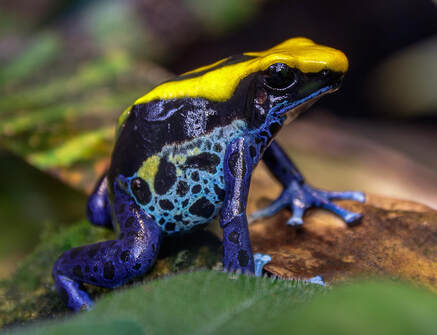Dyeing Poison Dart Frog

Common Name: Dyeing Poison Dart Frog
Scientific Name: Dendrobates tinctorius
Physical Description: The Dyeing Poison Dart Frog has a wide variety of colors; the most common morph sees a blue chest and legs with a yellow head. They are 1.5 to 2 inches in length on average and weigh up to 8.5 grams1. There are a wide variety of color variations within the species, some which have been deemed subspecies, such as the Blue Poison Dart Frog.
Males will call during the breeding season using modified 4-stroke respiration. Whereas humans breath with 2 strokes, in and out, frogs and toads use 4 strokes. Stroke one brings air into the buccal cavity (where their vocal sacs come off to expand). Stroke two moves air down into the lungs. Stroke 3 moves it back to the buccal cavity, and 4 is an exhalation. They will hold air in their buccal cavity and move it back and forth rapidly across their vocal cords to produce their unique sounds.
Habitat: They live in forests and inland wetlands2. These wetlands can be permanent or seasonal, and located by rivers, streams, creeks, springs, ponds, lakes and other sources of water.
Range: They can be found in South America in countries like Northern Brazil, Guyana, French Guiana, Suriname2.
Diet: An insectivore, the Dyeing Poison Dart Frog eats a wide variety of insects such as ants, beetles, and flies.
Life Span: They live 4-6 years in the wild and up to 12 in human3.
Social Structure: Dyeing Poison Dart Frogs breed during the Southern Hemisphere summer months of February and March3.
Status: Least Concern2
Other: Their toxicity comes from their diet! Human raised individuals are not toxic due to the lack of insects producing these toxins in their diet.
1 https://www.zoonewengland.org/stone-zoo/our-animals/reptiles-amphibians/dyeing-poison-dart-frog/#:~:text=About%20the%20Dyeing%20Poison%20Dart%20Frog&text=Their%20bright%20colors%20serve%20as,paralyze%20or%20kill%20a%20predator.
2 https://www.iucnredlist.org/species/55204/11265402
3 https://cosleyzoo.org/blue-poison-dart-frog/
Scientific Name: Dendrobates tinctorius
Physical Description: The Dyeing Poison Dart Frog has a wide variety of colors; the most common morph sees a blue chest and legs with a yellow head. They are 1.5 to 2 inches in length on average and weigh up to 8.5 grams1. There are a wide variety of color variations within the species, some which have been deemed subspecies, such as the Blue Poison Dart Frog.
Males will call during the breeding season using modified 4-stroke respiration. Whereas humans breath with 2 strokes, in and out, frogs and toads use 4 strokes. Stroke one brings air into the buccal cavity (where their vocal sacs come off to expand). Stroke two moves air down into the lungs. Stroke 3 moves it back to the buccal cavity, and 4 is an exhalation. They will hold air in their buccal cavity and move it back and forth rapidly across their vocal cords to produce their unique sounds.
Habitat: They live in forests and inland wetlands2. These wetlands can be permanent or seasonal, and located by rivers, streams, creeks, springs, ponds, lakes and other sources of water.
Range: They can be found in South America in countries like Northern Brazil, Guyana, French Guiana, Suriname2.
Diet: An insectivore, the Dyeing Poison Dart Frog eats a wide variety of insects such as ants, beetles, and flies.
Life Span: They live 4-6 years in the wild and up to 12 in human3.
Social Structure: Dyeing Poison Dart Frogs breed during the Southern Hemisphere summer months of February and March3.
Status: Least Concern2
Other: Their toxicity comes from their diet! Human raised individuals are not toxic due to the lack of insects producing these toxins in their diet.
1 https://www.zoonewengland.org/stone-zoo/our-animals/reptiles-amphibians/dyeing-poison-dart-frog/#:~:text=About%20the%20Dyeing%20Poison%20Dart%20Frog&text=Their%20bright%20colors%20serve%20as,paralyze%20or%20kill%20a%20predator.
2 https://www.iucnredlist.org/species/55204/11265402
3 https://cosleyzoo.org/blue-poison-dart-frog/






